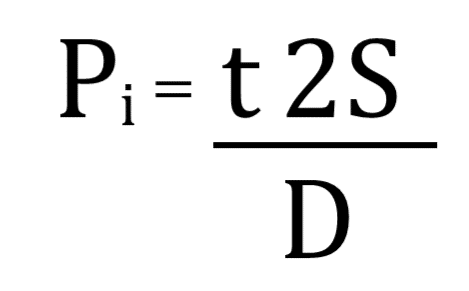What is the maximum internal pressure Ductile iron pipe (DI pipe) can handle, you ask? The simple truth is it depends entirely upon the size of the pipe and its wall thickness. And within any given DI pipe diameter there can be as many as 12 correct yet different answers, given the wide range of intermingled thickness class and pressure class pipe selections available.
Class History
More than a century ago, way back in the heydays of cast iron pipe, which some still refer to as grey iron pipe, there were as few as four wall classes available (A, B, C, and D). DI pipe entered the marketplace in the mid-60s ushering in a new wave of technological advancements and manufacturing possibilities, and by the mid-70s there were seven wall classes available (0 through 6). These DI pipe classes were quickly renamed class 50 through 56, given that a “0 wall pipe” does not sound as strong as it truly was.
Come 1991, with increased competition from alternate pipe materials as well as customer demand for a thinner wall DI pipe, the class selection grew to twelve, with Pressure Classes 150, 200, 250, 300, and 350 introduced in various diameters. Each of these pipe walls, Thickness Class and/or Pressure Class for modern DI pipe, are included in and governed by AWWA standards.
A Relationship Built on Pressure
The universal hoop stress equation is a cornerstone of hydraulic engineering. It is called “universal” because it applies to any piping material and describes the working relationship between the internal fluid pressure, the pipe size, and the pipe wall thickness.
Given a working pressure or design pressure you need to contain, the wall thickness is easily computed. If you know your wall thickness and wonder what pressure it can handle; the hoop stress equation is easily rearranged to solve for (P) pressure.
Where:
t = net thickness, in.
Pi = design internal pressure, psi = 2 (Pw + Ps )
Pw = working pressure, psi
Ps = surge allowance, 100 psi = equivalent of 2 fps velocity change in pipe
( if a larger surge potential is presumed or known to exist it should be used instead of the AWWA standard 100 psi ).
D = outside diameter of the pipe, in.
S = minimum yield strength of pipe material, psi = 42,000 psi for ductile iron
There is a very important distinction to make regarding the results obtained from each arrangement of the hoop stress equation shown above. When solving for t, the NET pipe thickness, this represents the minimum wall required to contain the DESIGN pressure used in the equation. The design pressure is not the maximum pressure the actual pipe can handle because standardized tolerances and allowances often add metal to the manufactured pipe wall, beyond the design requirement.
Per the AWWA C150 standard - Design of DI pipe - and related manufacturing practices, a casting tolerance, and a service allowance are ADDED to this net thickness which often results in a thicker final wall than the equation dictates. See the table below.
The Casting Allowance is a tolerance added to provide the latitude required by the manufacturing process and varies by pipe size. The Service Allowance is an added thickness of 0.08 inches for all pipe that provides an additional safety factor for unknowns. Any increase in the actual metal wall beyond the computed net design thickness likewise increases the pressure handling capability of the pipe. The table below illustrates this for various diameters designed for a 100-psi working pressure, which equates to a 400-psi design pressure per the AWWA C150 standard.
In the example tabulated above the available wall class that first exceeds the Total Calculated Thickness values shown were PC 350 for 8-in and 12-in, PC 200 for 24-in, and PC 150 for 36-in and 48-in DI pipe. While each of these Ductile iron pipes clearly perform well beyond their "label," the same cannot be said for alternate piping materials.
Given the superior innate yield strength of DI, affording a design factor of 25 times stronger than some other commonly used pipe materials in the water and sewer infrastructure marketplace, there’s no doubt that DI is the best material for handling variant or unexpected pressure surges.
The “What Can It Really Hold?” examples above were computed using the Internal Pressure and Materials Comparison Calculator contained within the McWane Pocket Engineer located online at pe.mcwane.com. This calculator presents several other comparative insights among the most common piping materials used today.
A Reality Check on Surge
A surge pressure is created when the velocity of fluid in a pipeline increase or decreases. This change can be gradual or sudden. The quicker the change occurs, the greater the surge result. In the worst of cases, this is often called water hammer.
All utility pipelines experience surges to varying degrees every day around the clock, based on whenever a particular community or other large-scale water users suddenly demand more water, such as shower-time in the morning for most folks, or the start-up of a water-dependent business such as manufacturing or similar that require water for cooling.
Many pipeline materials are weakened over time by the continual effects of surge pressures, but NOT ductile iron. Ductile means flexible, able to deform and return, to flex without rupture or breaking. Simply put, ductile iron is not weakened or otherwise adversely affected by loading cycles, internal or external.
An additional assurance of lasting quality with DI pipe is that every single piece manufactured, in accordance with the AWWA C151 Manufacturing standard, is hydro-statically tested to at least 500-psi of internal water pressure before it is cement-lined and painted. If there is any discrepancy or insufficiency in the pipe itself this test will expose it, often resulting in the destruction of the errant pipe itself.
It truly is a no-holds-barred pressurized proof of long-term fitness for duty. One can also appreciate that the foundry hydro-static test far exceeds the typical 150 or 200-psi post-installation hydro-static test that a contractor applies to the finished pipeline.
McWane Ductile is pleased to conduct focused and intensive testing for our customers on Ductile iron products in our state-of-the-art testing facility located at our Ohio facility. See the video below to learn more.
Simply Put…Ductile Iron Pipe is Superior
With DI pipe, do not be fooled or deterred by the label of some lower Pressure Class pipes. In fact, ductile iron is the only pipe material in the modern utility marketplace that commands a designer to perform the full three-pronged design analysis - Internal Pressure, Bending Stress design, and Deflection design – as outlined in the AWWA C150 DI Pipe Design standard. There is an easy to use Thickness Design Calculator contained within the Mcwane Pocket Engineer located online at pe.mcwane.com.
Additionally, for more details on the difference between Pressure Class and Thickness Class of DI pipe, see the helpful blog and video by my colleague, Jeremy Gwin, McWane Ductile Senior Sales Representative.
Need Assistance with Your Waterworks Project?
If you have any questions or require additional information, please feel free to contact your local McWane Ductile representative. We have team members who’ve managed small and large water utility systems, served in engineering consulting firms, and bring decades of experience in solving field issues involving pipeline construction and operation. From design to installation, we take great pride in providing education and assistance to water professionals throughout the water and wastewater industry.
Check Out All Our Digital Offerings














